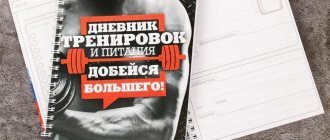organization and discipline are often the determining factor for success in sports. One of the tools that helps novice athletes organize their training process in the gym is a training diary.
From this useful article, you will not only understand what a training diary actually is and why you need it, but you will also answer your questions :
- Do I need him?
- Does it really help you train?
- How to lead him if I want to train with him?
- How to analyze the results?
- Where can I download a diary template for the gym?
You will also receive a number of other answers to popular questions about keeping a training diary.
What is a training diary?
Before we tell you about a training diary, you should have a proper understanding of it and what it is all about.
A training diary is a record in electronic (digital) form or on paper (notepad, notebook, etc.) of your training program, which helps not only to monitor progress in the training process, but also to organize the training itself in order to eliminate confusion when performing exercises and approaches, as well as observing their order , well, of course, in general, it helps to correctly adjust the load, number of approaches and rest time when performing physical exercises.
Such a big definition, but very simple to understand, if we say in two words what a training diary is - these are records of maintaining a training program that you yourself keep from training to training.
Since we mentioned that there are two types (digital and paper), I would like to say a few words about each, list their advantages and disadvantages , and in the future you will be able, easily based on the listed + and -, to choose the desired type of training for yourself. diary.
What is a training diary?
Who needs a training diary?
It is suitable for anyone who plays sports: from jogging in the morning to daily strength training with heavy weights. The main purpose of the diary is to track progress and your own feelings, which will allow you to control the state of your body and avoid injury.
Photo: istockphoto.com
Keeping a fitness diary will be especially useful for beginners. Regular recordings will help you choose the optimal weight and correctly assess your capabilities.
Getting to know fitness: how to do your first gym session
What types of training diaries are there?
Each athlete has the right to choose which type of training diary to use, but you must know objectively all the pros and cons of each of them, so that later there are no misunderstandings when keeping records of the training process.
On paper
The traditional way of keeping a training diary, which is preferred by “old school” athletes
pros
- To keep training records, you only need a pen /pencil, for some, a calculator and a notebook/ notebook (48 or 96 sheets)
- Easy to fill out, not requiring any special knowledge of modern technology
- There is nothing superfluous, you yourself can adjust (remove or add) if necessary any item for maintaining the training program
Minuses
- You can lose all your training records if your diary is damaged or lost
- Subject to natural wear and tear , especially if you store the diary in improper conditions (therefore, if you choose this type of diary, immediately laminate it or cover it with tape)
- After completing working approaches, you have to constantly approach the place where the training diary is located
- Recalculation of working weight in case of progress or regression, as well as filling out the diary itself, is done manually
Training diary in paper form
Thus, we can say that the paper form of a training diary is not entirely suitable for athletes who are accustomed to using high-tech development products.
In electronic (digital) form
Anyone who wants to keep up with the times should definitely try to work with an electronic diary, an experiment evaluate the advantages and disadvantages. Well, for now we’ll voice our pros and cons of digital diaries.
pros
- No need to take additional notepads/notebooks, pens with you, you already have everything in your gadget (tablet, phone)
- Many applications that specialize in developing training diaries also offer a look at the technique of each exercise with a training program for certain muscle groups depending on the level of fitness.
- Automatic recalculation of working weight if you indicate your maximum (lifted weight for one repetition)
- Photos of the figure , anthropometric data can be structured by date, and then, if necessary, quickly, easily and demonstratively track your training progress/regression
- You can make a backup of your training diary (copy and restore) in case of data loss, a very useful feature
Minuses
- You must have at least a little understanding of smartphones and tablets (be able to install applications on Android / IOS, register with services)
- Very often, the application developer “crams in” a lot of unnecessary information, which causes confusion when filling out the diary.
- Some diaries are paid , you have to pay a one-time fee for use, usually from 400 to 600 rubles.
- Annoying in apps
- Very dubious training programs that are offered to beginners or experienced athletes (if this functionality is “built into” the application)
Electronic training diary
In general, if you find an application that contains “nothing superfluous”, then you can use it, but since bodybuilding is shrouded in stereotypes and myths that are still spread everywhere, from the “local gym” to the popular “jock” applications , then we probably won’t see an application for a very long time that will reflect the correct training process and be conveniently filled out.
If you read the reviews of the developers, they are far from delighted with the profits from the sale of diaries, since electronic training diaries are not as popular among athletes.
As for our preference, if anyone is interested, we give it to the paper form , the template of which you will see below. There is nothing superfluous in it, everything is only the most necessary, without distracting the athlete from the training process.
Diary options
- For a year - a spiral notebook in which successes for a year or more will be stored. Because people often go to the gym intermittently.
- For the season (12 weeks) - a notebook on a spiral or a paper clip; you can make it in A6 format (10x15 cm). It tells people about the peculiarities of training at certain times of the year. For example, make summer diaries with bodyweight exercises. You can additionally talk about the exercises on your social networks. Increase the number of subscribers and make money on sales.
- Series - if you have a concept of how to combine all this during the year.
- For a marathon - for example, you organize a spring fat-burning marathon, where everyone does the same exercises every day and records the results. People will write down, photograph the pages and show them to their friends. Even if the marathon is free, you can sell notebooks and make money.
- Electronic – You can also sell pages electronically so that people can print them out and fill them out.
You can end up with a whole series of training diaries in different formats and price ranges.
And for yourself, you can order a solid diary in a book binding and a faux leather cover. In which he will record the progress of his students. And you will instill in them the need to record the training process.
Write to us, we will be happy to advise you on the materials, draw a layout and select the appropriate type of notebook.
Download free training diary template
We present to you a simple, convenient template that will not confuse you, it will be easy to train with it.
Downloads: 577, size: 39.8 KB, date: 24 Sep. 2021
We deliberately do not send you various templates that are circulating on the Internet, so as not to confuse you, because they all contain a lot of unnecessary information that only distracts from training, and the filling process turns into “hard labor.”
How to keep a training diary?
We will describe keeping a diary based on the above template.
There are only two sheets, the first consists of
- Exercise names
- Day and week number
- Number of approaches
But before you describe the meaning of each entry , you need to set the right goals and objectives for yourself, that is, ultimately what you want to achieve from the training program . For example, increase strength in basic exercises by 15-20 kg, gain muscle mass +10 kg. And gradually go towards them.
How to carry a training diary?
Meaning of entries
Each entry in the diary helps to systematize the training process, while all unnecessary items that only distract from the training itself and confuse the athlete are removed as much as possible from the diary.
We will start with the first sheet, which is also the main one , in which all the most important values will be entered when conducting the training process.
Name of exercises
This column directly indicates the exercises that you plan to perform in training, starting, as you remember, with basic exercises (squat, bench press, deadlift), and ending with isolated (auxiliary) exercises if desired.
Training diary (sheet No. 1)
Day and week number
The week number is located in the uppermost corner; it is needed in order to count the number of training weeks that will make up microcycles and, ultimately, megocycles (remember our fullbody).
In the “days of the week” column we indicate the working weight with which you need to work in the exercises, and under it the number of working approaches and repetitions, for example Monday (90 kg, 4x8), means that on Monday the exercise is performed with a working weight of 90 kg in 4 sets of 8 to seven repetitions.
Number of approaches/repetitions
This column is located in the same column as the type of exercise, this is done so that there is no confusion when marking completed approaches and repetitions .
filled out as follows: first write the name of the exercise, and below it the number of approaches and repetitions actually performed, and in it you can also indicate the degree of fatigue of your muscles. For example, you perform squats with a barbell on your shoulders in three approaches for 12 repetitions, respectively, under the name of the exercise (squats with a barbell on your shoulders), note the number of repetitions and approaches performed and your fatigue , as follows: 12, 12, 12 (-2 ), or 12, 12, 12 (+), the first option will mean that approaches performed for three sets of 12 repetitions, but the extreme approach was performed hard , namely the last two repetitions were very difficult, and vice versa, with the second recording option will mean that the approach was completed “easy ” , - the (+) icon means that it easy to perform - a signal for you that in the next workout, when you need to perform the same number of repetitions and approaches, you can increase the working weight in the exercise .
How to keep a training diary (sheet No. 2)
The second sheet of the training diary consists of your anthropometric data, which we recommend measuring at the same time, in the same clothes, and on an empty stomach, for example, in the morning and no more than once a month.
This sheet states:
- Date (for example, 10/10/2021, then it will be 11/10/2021)
- Weight (your weight without clothes, on an empty stomach)
- Circumference (waist, hips, chest, biceps)
- Other (any other information that you consider important for yourself is indicated here, for example, you were sick for a week, etc.)
To be completely honest, but if you are not a fan of bodybuilding, then you don’t need a second sheet , the main attention should be paid to the progression of the load , if there is one, then you are on the right path, following your strength indicators, muscle volumes will definitely increase masses.
Analysis of results
In order to analyze the results, we will clearly demonstrate a diary filled out for one day, in which we will substitute the experimental values and explain to you each figure.
In the photo you see a training record for one exercise (horizontal bench press) filled out for three days of training at once (Monday, Wednesday and Friday). Under the name of the exercise, all the completed approaches and the number of repetitions , as well as how difficult it was to complete the approach (this is indicated by the “+” sign means easy and “-” means very hard, and exactly how many repetitions are indicated next to it).
If everything went as usual, according to the planned plan , neither easy nor difficult, but absolutely as written in the training program, then the “+” and “-” signs can be omitted.
Your task, as an athlete who wants to increase strength indicators and increase muscle mass, is to strive for progression of the load. In order to be able to easily and quickly assess this very progression of the load, a training diary will help you and will help you.
Training diary analysis
You can progress in different ways:
- Increase the number of repetitions in sets
- Increase the number of completed approaches
- Increase the working weight on the barbell
- Reduce rest time between sets
- Increase the time spent doing the exercise
However, we are for the traditional version of load progression, that is, for the third, when the athlete increases the working weight on the barbells, just not from workout to workout (as many illiterate trainers/bloggers and sports Internet resources recommend), but gradually , by alternating light, medium and hard training.
In addition, the training diary not only systematizes the training program, but can also tell you why, for one reason or another, you, say, “didn’t press” or “didn’t squat.” That is, you don’t need to keep all the information on approaches and repetitions in your head , everything is in the diary, by looking into which you can determine with what intensity, load you did the previous workout, and how well it went overall for you, thereby helping yourself find the answer yourself why your strength indicators have stopped.
By tracking the working weight in the exercises on training days, as well as the degree of load, how easy or hard certain approaches were given, you can easily adjust your further training plan in order to most accurately approach periods of supercompensation (when muscles/strength grow in rest period).
Analyzing the training diary (progress/regression of the training process)
As for the second sheet (with anthropometric data), this is basically a wish, the most accurate measurements are your mirror , if you see a positive change in it, it means you are going in the right direction. Those who want to be more precise can, of course, fill out anthropometric indicators once a month and make a photo report of their figure for themselves.
To measure a bodybuilder's anthropometry, you only need a measuring tape , a bathroom scale, and a phone with a camera.
Gym Hero Pro
Gym Hero is also available in paid and free versions. I deliberately recommend buying the pro version right away, since the free version contains a huge number of in-app purchases, the amount of which for some reason is much greater than the cost of the paid version of the application. Gym Hero has all the tools you need to track your workout progress. There is also a timer for stretching and synchronization with iCloud.
Gym Hero Pro
Big Mike Alright
Price: 279.00 rubles
Download
Price: 279.00 rubles
Tips for keeping a workout diary
We invite you to familiarize yourself with tips that will help you fill out your training diary more effectively, faster, more efficiently and, in our opinion, correctly.
In order not to run to the diary every time after completing an approach, fill it out in advance , for example, at home, before training ( 80% can be filled out - warm-up approaches, you can do them without difficulty, and you can even fill out the first two or three working approaches, and also the name of the exercises)
We begin to fill out a diary indicating the day of the week, date and name of the exercises. First of all, you must perform basic exercises , and only then, if your program contains isolated ones. The base means - squats with a barbell on the shoulders/horizontal bench press/deadlift, and after that we do everything else; for those interested, read our article on how to properly create a training program.
Tips for keeping a workout diary
We measure body weight, the volume of arms, legs, and so on at the same time, for example, in the morning, and naturally not after training , when the muscles are warmed up and swollen.
As already indicated in the first paragraph, we fill out the warm-up approaches in the diary in advance, part of the work at our discretion , for example, if you feel good, slept well, ate, are confident in your abilities, you can fill in part of the work approaches in the exercises, so that there is less fuss when filling out your training diary
It happens, especially among experienced athletes, that during warm-up approaches , he already understands whether he can handle the planned working weight in all approaches and repetitions. Therefore, if you already feel during the warm-up that you cannot handle , it is better to reduce it by 2.5-5 kg , in order to avoid violation of the execution technique and injury
Mark for yourself the completed working approaches in basic exercises with the + and - sign, so that when you open the diary you immediately remember how hard the weight was for you when performing the exercises. Accordingly, if “plus” means that the approach was completed easily , “minus -1 or -2” means that the last one or two repetitions were difficult
There will be nothing wrong if instead of 2 minutes between approaches, you rest for 3, but during this time the level of creatine phosphate will recover and you will complete the planned repetitions “without loss”, which means that the diary will show “+” instead of “–” (in case of little rest between approaches).
When filling out the training diary, we carefully write out the warm-up approaches , they should be at the beginning significantly less than the working ones, for example, you plan to lift an 80 kg barbell in 4 approaches for 8 times , which means your warm-up should be like this: empty bar once for 16, 40 for 12 reps, 60 kg for 8 reps, 70 kg for 6 reps and then there are working approaches. The closer the number is to the working approach, the smaller the step between the weights on the barbell, in other words, you shouldn’t have 40 for 8 repetitions, 70 for 6 repetitions and working, it’s important to gradually increase the weights , but you can’t get carried away, you can overwork the muscles and it’s fine "don't shake."
Conducting the training process
In your diary, you can note the intake of sports nutrition (for example, in this month you consumed a lot of creatine and protein, etc.), this information will help you analyze the reason for the drop in strength or muscle mass
not necessary in the diary (for example, barbell curls, dumbbell flyes on a bench, and so on), since your main task is to progress in basic exercises - if you grow in them, then your strength and muscle mass will also grow.
This is where our advice ends, perhaps you will have additions , write in the comments to this article.
What can you add to your training notebook?
- Tables with approaches and repetitions.
- Body structure and names of the main muscles.
- Basic information on types of exercises.
- Dietary recommendations.
- Motivation.
- Frequency tracker.
If you create a truly useful notebook, it can become a guide for those new to the world of fitness. And it can even be sold independently, so that people first get acquainted with your system, and then sign up for training.
It is necessary to add all your contact information and a description of the services you provide. It will also be useful for existing customers to see this information and not have to search if necessary.
Where to start compiling a training diary?
- Gather all the materials you print to clients.
- Write down everything you say most often.
- Draw the structure of a training data record.
Send it to a printing house, for example, to our Notepad Workshop padMasters.ru.
How to determine the number of pages?
For example, let's take the standard A5 format (like all notebooks). If the recording of one workout takes up an entire page, and you train 2 times a week, then your notebook for the year will have 104 pages (52 weeks a year). And additional pages with contacts, reference material and tips.
Do I even need a training diary?
Many athletes wonder if they even need a training diary or is it a waste of time and effort? To answer this question, you need to know each person personally, know how he organizes his affairs, for some it is easier to keep all the information and training program in their head, and for others it is easier to write everything down and then track “without straining” your regression or progress.
As practice shows, novice athletes keep a training diary, simply so as not to get confused in the set of exercises or get lost in their order. Experienced athletes prefer to “keep” everything in their heads, since they train using the same methods year after year and remember “light” and “hard” approaches on a mental level.
If you are a beginner athlete, then we strongly recommend that you get a training diary (digital or paper of your choice) and record all your ups and downs there, and only then, when you gain experience and knowledge, you bring the training process to automaticity - you can give up from keeping a training diary.
Do you even need a training diary?
It is also impossible not to say that for some people a training diary can become a motivator to plow again and again in the gym , but if you open a photo of what he was like in his best years, at the peak of physical fitness, nostalgia you, and you will involuntarily reach for the hardware.











